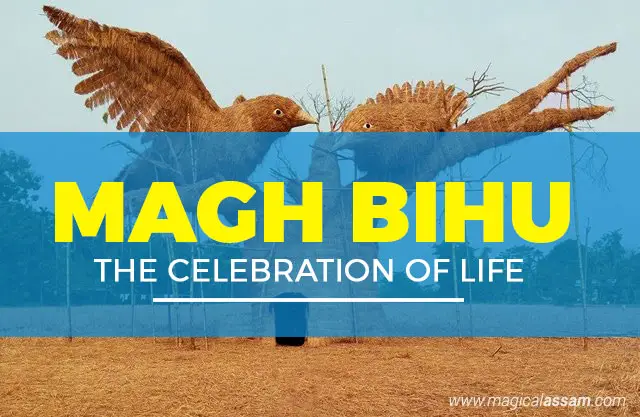Just like Lohri in Punjab and Pongal in Tamil Nadu, Magh Bihu is one of India’s many harvest festivals—though this particular celebration unfolds in the northeastern state of Assam. Observed during mid-January, Magh Bihu (also known as Bhogali Bihu) signals the end of the harvest season and expresses gratitude for nature’s bounty.
As is true of most Indian festivals that revolve around harvests, Magh Bihu is steeped in community gatherings, large feasts, and spirited bonfires, reflecting an age-old tradition of sharing, thanksgiving, and merriment.
A defining feature of Magh Bihu is the construction of temporary huts, called bhela ghar, made from bamboo, thatch, and dried leaves. Families and neighbors come together to prepare traditional delicacies—particularly an assortment of rice-based sweets and savory snacks known as pithas and larus (coconut and jaggery sweet balls).
On the eve of Magh Bihu, people spend the night in these huts, feasting on the freshly prepared food, singing folk songs, and rejoicing in the warmth of communal bonds. At the break of dawn, the huts are ceremonially burned as a symbolic offering to the gods, and everyone gathers around a central bonfire called Meji.
This ritual, which involves prayers and offerings, serves as a heartfelt expression of gratitude for the successful harvest and hopes for prosperity in the year ahead.
While the feasting and bonfires might seem familiar to anyone who has witnessed Lohri or Pongal celebrations, Magh Bihu has its own unique customs and folklore deeply rooted in Assamese culture and history.
Beyond its role in agriculture, the festival fosters togetherness and cultural identity, strengthening social ties through shared meals, songs, and dances. From crafting intricate rice cakes to lighting the Meji, every tradition associated with Magh Bihu underscores the importance of community and the cyclical harmony between people and the land.
Here are 7 fascinating facts about Magh Bihu that highlight its vibrant spirit and cultural significance.
1. The Festival of Food
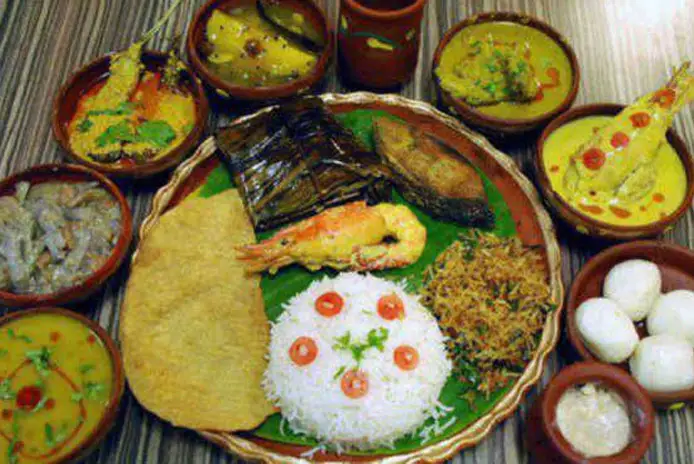
Magh Bihu, celebrated on the first day of Magh in the Assamese calendar, is also known as Bhogali Bihu. The word “Bhogali” signifies the abundance of rich food, making this festival a grand feast at its core. Since Magh Bihu marks the end of the harvest season, it is observed when all the cultivation work is done, ensuring plenty of produce for everyone to enjoy.
2. The Night Before
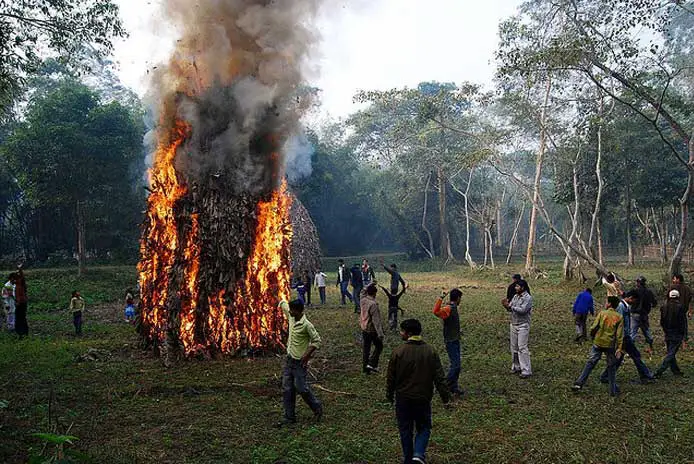
Bhogali Bihu festivities begin one day before the main celebration, on the last day of the month of ‘Puh.’ On this eve, people construct the ‘Meji,’ a wooden structure, and the ‘Bhela Ghar,’ a thatched hut. Early the next morning, often around 5 a.m., these structures are burned in a ritual offering, and prayers are offered to the Fire God.
3. Jolpaan – Pithas, Laru, Handoh and Kumal Chaul
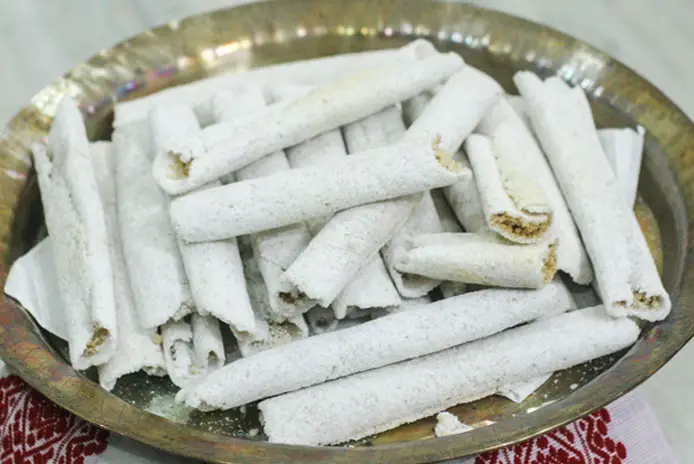
On the morning of Bihu, people begin their day with Jolpaan, which includes traditional delicacies like Pithas, Laru, Handoh, and Kumal Chaul. A grand feast follows at lunchtime, featuring Sunga Bhat (sticky rice cooked in a hollow bamboo), along with meat, fish, vegetables, and other savory dishes.
4. The Bihu Day
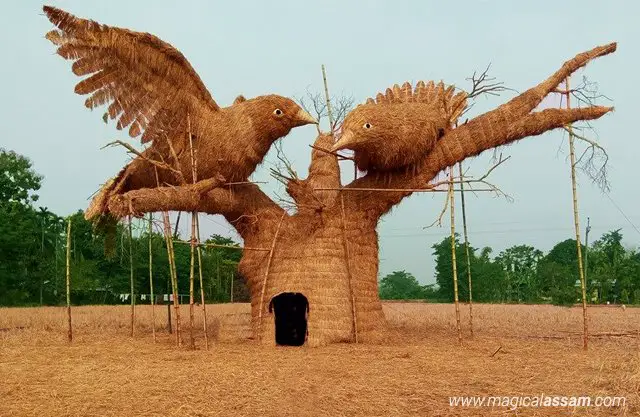
On the day of Magh Bihu, everyone takes bath at the dawn and proceed to the meji. The Meji is lit up by one old individual from the society or village. Every one of the villagers get together in the Meji and complete numerous ceremonies. Different sorts edibles like coconut, betel nut, and so on are worshiped to the Meji (Agni Devta). Various types of potatoes, mitha aloo, muwa aloo, etc. are roasted in the large fire of meji and everyone eats from children to old people eat it. Youths also enjoy with cracker like thing made of bamboo called ‘Hiloi’.
5. The Most Thrilling Bull-Fight
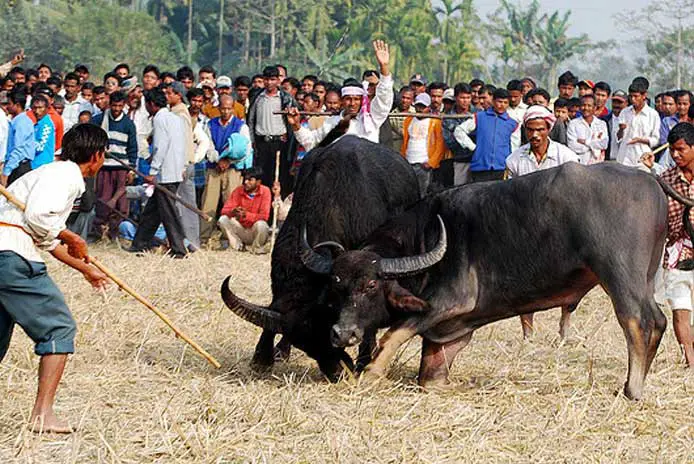
Bhogali Bihu is marked by various special events and among them the most thrilling one is the bull-fight. There are bull fights across the villages and smaller towns across Assam held in open spaces where large crowds from villages come and view these fights.
The bulls are taken from the villages and pitted against each other and the winner bull and the master are awarded prizes.
6. The Bird-Fight and The Egg Fight
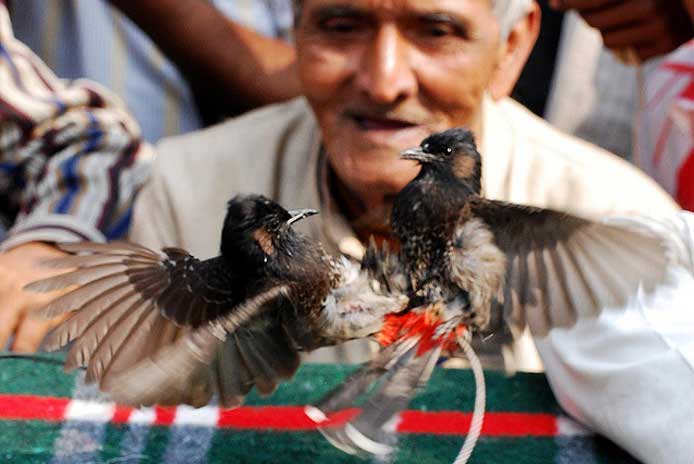
Another special events that take place are bird-find and the egg-fight. In egg fights, two or multiple players play against each other and the winner is the one whose eggs do not crack open when the competitors try to break them.
7. After All.. Its a Celebration of Life
No matter where you live—Delhi, Mumbai, New York, or Los Angeles—no matter how luxurious your lifestyle is, if you don’t make it back home to spend these special days with family and old friends in your village, you’re missing out. Deep down, you know exactly how that feels.
Interesting Fact : An Assamese film called “Jooj” based on the buffalo fight won a Rajatkamal in the 38th National Film Awards in 1990.

